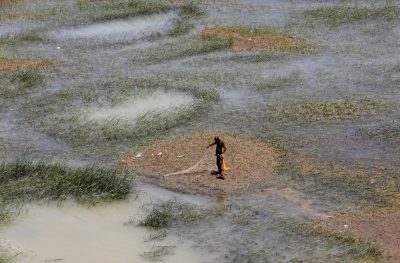China
Smarter strategies for sharing South Asia’s rivers

Author: Ashok Swain, Uppsala University
South Asia is facing severe water scarcity. As the region’s population grows and its economies develop, a lack of sustainable water development strategy is leading to increasingly acute water shortages.
The region is home to nearly 2 billion people, almost half of which depend on the large river systems shared among countries. There are two major international river systems in the region: the Indus and Ganges-Brahmaputra. While the Indus basin is shared by Afghanistan, China, India and Pakistan, the Ganges-Brahmaputra is shared by Bangladesh, Bhutan, China, India and Nepal.
But no regional organisations manage these precious water resources. Instead, water is shared according to bilateral agreements. Notable are the 1960 Indus Treaty between India and Pakistan, the 1996 Ganges Treaty between India and Bangladesh and the 1996 Mahakali Treaty between India and Nepal. India and Bhutan also have a series of hydropower generation agreements.
None of these agreements are comprehensive in scope or nature. The Indus Treaty is primarily a river sharing agreement, while the Ganges Treaty is a water-sharing agreement. The Mahakali Treaty — which is yet to be implemented — is a benefit-sharing agreement.
The South Asian region is water-rich but with huge seasonal variations. In the absence of mutually beneficial, comprehensive agreements to store and develop water resources, there is always a fear that upper riparian countries will unilaterally exploit the rivers for their own benefit. This may have far-reaching effects on downstream countries.
Since 2016, in spite of the 1960 agreement, India has repeatedly threatened to divert water from the Indus away from Pakistan. In the Ganges basin, India has also been diverting water away from Bangladesh since 1975, though that diversion is presently regulated under the 1996 Agreement. India has also made proposals to divert water from the Brahmaputra inland, instead of allowing water to flow into Bangladesh.
After becoming the prime minister of India in 2014, Narendra Modi revived old plans to link 30 of the country’s major rivers and divert the Ganges-Brahmaputra. This grand plan intends to provide water to India’s arid provinces — but it is causing anxiety among the country’s smaller neighbours. Some rivers have already been connected, but the proposal requires the construction of large dams in India, Nepal and Bhutan in order to go ahead, as they share the Ganges-Brahmaputra. This will require India to enter into agreements with these countries.
Linking major rivers of the region could create more regional water disputes instead of resolving the existing ones. In South Asia, failure to find negotiated settlements over water in the past has contributed to the rise of tensions between states. Only in the case of the 1960 Indus Treaty did India and Pakistan accept mediation by the World Bank. In all other water disputes, India has strictly adhered to the practice of bilateral negotiation. Though this approach has strengthened India’s position as a regional power, it has kept the past disagreements alive and limited wider plans to develop the region’s water resources.
The growing threat of climate change and its impact on water demand and supply in the region means South Asian countries can no longer continue with the old bilateral approach — particularly given China’s growing interest in harnessing river resources. In the last decade, China has built two hydropower dams on the Indus and Brahmaputra, and two more dams are presently under construction. All these developments have further increased the dynamics of water conflict, as well as the need for India to cooperate over the region’s scarce shared water resources.
China’s water projects upstream have threatened India’s position as the dominant riparian in these two basins. This has prompted India to explore collaborating with Bangladesh, Bhutan and Nepal in the Ganges-Brahmaputra basin, and to seek support for dam-building in the Afghan part of the Indus basin.
Riparian countries in South Asia should work towards establishing lower basin-based water management institutions — as the lower basin countries in the Mekong basin have been doing since the 1990s. Cooperation among lower riparian countries is needed not only to address increasing water scarcity in the dry-seasons and devastating floods in the monsoon periods, but also to effectively protect their water supply from China. Unilateral actions by South Asian countries, particularly India, to protect…
China
Is journalist Vicky Xu preparing to return to China?

Chinese social media influencers have recently claimed that prominent Chinese-born Australian journalist Vicky Xu had posted a message saying she planned to return to China.
There is no evidence for this. The source did not provide evidence to support the claim, and Xu herself later confirmed to AFCL that she has no such plans.
Currently working as an analyst at the Australian Strategic Policy Institute, or ASPI, Xu has previously written for both the Australian Broadcasting Corporation, or ABC, and The New York Times.
A Chinese language netizen on X initially claimed on March 31 that the changing geopolitical relations between Sydney and Beijing had caused Xu to become an expendable asset and that she had posted a message expressing a strong desire to return to China. An illegible, blurred photo of the supposed message accompanied the post.
This claim was retweeted by a widely followed influencer on the popular Chinese social media site Weibo one day later, who additionally commented that Xu was a “traitor” who had been abandoned by Australian media.
Following the publication of an ASPI article in 2021 which exposed forced labor conditions in Xinjiang co-authored by Xu, the journalist was labeled “morally bankrupt” and “anti-China” by the Chinese state owned media outlet Global Times and subjected to an influx of threatening messages and digital abuse, eventually forcing her to temporarily close several of her social media accounts.
AFCL found that neither Xu’s active X nor LinkedIn account has any mention of her supposed return to China, and received the following response from Xu herself about the rumor:
“I can confirm that I don’t have plans to go back to China. I think if I do go back I’ll most definitely be detained or imprisoned – so the only career I’ll be having is probably going to be prison labor or something like that, which wouldn’t be ideal.”
Neither a keyword search nor reverse image search on the photo attached to the original X post turned up any text from Xu supporting the netizens’ claims.
Translated by Shen Ke. Edited by Shen Ke and Malcolm Foster.
Asia Fact Check Lab (AFCL) was established to counter disinformation in today’s complex media environment. We publish fact-checks, media-watches and in-depth reports that aim to sharpen and deepen our readers’ understanding of current affairs and public issues. If you like our content, you can also follow us on Facebook, Instagram and X.
Read the rest of this article here >>> Is journalist Vicky Xu preparing to return to China?
China
Guide for Foreign Residents: Obtaining a Certificate of No Criminal Record in China

Foreign residents in China can request a criminal record check from their local security bureau. This certificate may be required for visa applications or job opportunities. Requirements and procedures vary by city. In Shanghai, foreigners must have lived there for 180 days with a valid visa to obtain the certificate.
Foreign residents living in China can request a criminal record check from the local security bureau in the city in which they have lived for at least 180 days. Certificates of no criminal record may be required for people leaving China, or those who are starting a new position in China and applying for a new visa or residence permit. Taking Shanghai as an example, we outline the requirements for obtaining a China criminal record check.
Securing a Certificate of No Criminal Record, often referred to as a criminal record or criminal background check, is a crucial step for various employment opportunities, as well as visa applications and residency permits in China. Nevertheless, navigating the process can be a daunting task due to bureaucratic procedures and language barriers.
In this article, we use Shanghai as an example to explore the essential information and steps required to successfully obtain a no-criminal record check. Requirements and procedures may differ in other cities and counties in China.
Note that foreigners who are not currently living in China and need a criminal record check to apply for a Chinese visa must obtain the certificate from their country of residence or nationality, and have it notarized by a Chinese embassy or consulate in that country.
Foreigners who have a valid residence permit and have lived in Shanghai for at least 180 days can request a criminal record check in the city. This means that the applicant will also need to currently have a work, study, or other form of visa or stay permit that allows them to live in China long-term.
If a foreigner has lived in another part of China and is planning to or has recently moved to Shanghai, they will need to request a criminal record check in the place where they previously spent at least 180 days.
There are two steps to obtaining a criminal record certificate in Shanghai: requesting the criminal record check from the Public Security Bureau (PSB) and getting the resulting Certificate of No Criminal Record notarized by an authorized notary agency.
This article is republished from China Briefing. Read the rest of the original article.
China Briefing is written and produced by Dezan Shira & Associates. The practice assists foreign investors into China and has done since 1992 through offices in Beijing, Tianjin, Dalian, Qingdao, Shanghai, Hangzhou, Ningbo, Suzhou, Guangzhou, Dongguan, Zhongshan, Shenzhen, and Hong Kong. Please contact the firm for assistance in China at china@dezshira.com.
China
China Unveils Plan to Upgrade Industrial Equipment

China unveiled a comprehensive action plan for upgrading industrial equipment, with a focus on driving technological innovation and economic growth. The plan, released on April 9, 2024, aims to enhance competitiveness and sustainability within the manufacturing sector through extensive investment and regulatory support.
China announced an ambitious action plan for industrial equipment upgrading, which aims to drive technological innovation and economic growth through extensive investment and regulatory support.
On April 9, 2024, China’s Ministry of Industry and Information Technology (MIIT) and six other departments jointly released a notice introducing the Implementation Plan for Promoting Equipment Renewal in the Industrial Sector (hereafter referred to as the “action plan”).
Finalized earlier on March 23, 2024, this comprehensive action plan addresses critical issues related to technological innovation and economic development. It reflects China’s proactive stance in enhancing competitiveness and sustainability within its manufacturing sector. The initiative underscores the recognition of industrial equipment upgrading as a top policy priority.
The scope of China’s action plan to upgrade industrial equipment in manufacturing, is extensive, covering various aspects such as:
In line with China’s ambitious goals for industrial modernization and sustainable development, the action plan outlines several key objectives aimed at driving substantial advancements in the industrial sector by 2027.
These objectives encompass a wide range of areas, from increasing investment to enhancing digitalization and promoting innovation, including:
The objectives and key actions proposed in the action plan are summarized below.
This article is republished from China Briefing. Read the rest of the original article.
China Briefing is written and produced by Dezan Shira & Associates. The practice assists foreign investors into China and has done since 1992 through offices in Beijing, Tianjin, Dalian, Qingdao, Shanghai, Hangzhou, Ningbo, Suzhou, Guangzhou, Dongguan, Zhongshan, Shenzhen, and Hong Kong. Please contact the firm for assistance in China at china@dezshira.com.






